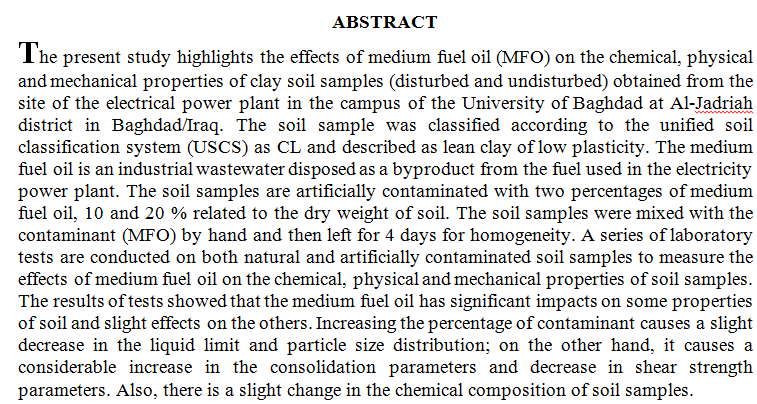
The objective of this study is to determine the concentration of copper and lead (mg/L) in drinking water by using absorption spectrophotometic and Atomic Absorption spectrophotometric method from different area in Baghdad and with different intervals , The results show that the concentration of copper and Lead ( mgL) in tap water which remains motionless in plumbing system for following periods one hours, 3 hours, 6 hours, 12 hours, 24 hours, 7 days and 14 days are (1 , 2.2 , 4 , 5.3 , 7.5 , 10 and 16 mgL copper ) & ( 0.3, 0.5 , 0.8 , 1 , 2.5 , 3 , 3.8 mg /L lead ) respectively .from these results its clear that high levels of copper & Lead occur if tap water comes in contact with copper - lead plumbing and copper lead -containing fix
... Show MoreBackground: Phytotherapy is the usage of herbal species with medicinal properties for the management of various diseases. Gingivitis and periodontitis are diseases that involve the role of both the bacteria and the host immune response. Over the years, various researches have shown the importance of herbal products in the management of periodontal diseases. Aims of the study: To evaluate the efficacy of locally applied Salvia officinalis gel as adjunctive in the treatment of chronic periodontitis. Subjects and methods: Fourteen patients (10 males and 4 females) with chronic periodontitis were enrolled in the present study with total number of twenty-eight periodontal pockets utilizing a split mouth design, the pockets were divided i
... Show MoreThe characteristic of our time is the tremendous technological progress and the wide use of the Internet. Children have had a large share of this progress.as they are becoming fond of having the technological equipment of tablets and mobile phones which become indispensable for these children cannot do without them .
Recently, the phenomenon of using mobile phones and tablets by children has become more widespread, and the society in general and parents, in particular, have ignored the reasons for their health .Despite the many advantages and benefits for children who are well trained to use these devices properly that have enhanced their cognitive and social abilities, there are many disadvantages that could harm children's growth if
In this investigation, the mechanical properties and microstructure of Metal Matrix Composites (MMCs) of Al.6061 alloy reinforced by ceramic materials SiC and Al2O3 with different additive percentages 2.5, 5, 7.5, and 10 wt.% for the particle size of 53 µm are studied. Metal matrix composites were prepared by stir casting using vortex technique and then treated thermally by solution heat treatment at 530 0C for 1 hr. and followed by aging at 175 0C with different periods. Mechanical tests were done for the samples before and after heat treatment, such as impact test, hardness test, and tensile test. Also, the microstructure of the metal matrix composites was examine
... Show MoreThis study investigates the application of hydraulic acid fracturing to enhance oil production in the Mishrif Formation of the Al-Fakkah oilfield due to declining flow rates and wellhead pressures resulting from asphaltene deposition and inadequate permeability. Implementing acid fracturing, an established technique for low-permeability carbonate reserves, was essential due to the inadequacy of prior solvent cleaning and acidizing efforts. The document outlines the protocols established prior to and following the treatment, emphasizing the importance of careful oversight to guarantee safety and efficacy. In the MiniFrac treatment, 150 barrels of #30 cross-linked gel were injected at 25 barrels per minute, followed by an overflush wi
... Show More (1)
(1)
The physical and elastic characteristics of rocks determine rock strengths in general. Rock strength is frequently assessed using porosity well logs such as neutron and sonic logs. The essential criteria for estimating rock mechanic parameters in petroleum engineering research are uniaxial compressive strength and elastic modulus. Indirect estimation using well-log data is necessary to measure these variables. This study attempts to create a single regression model that can accurately forecast rock mechanic characteristics for the Harth Carbonate Formation in the Fauqi oil field. According to the findings of this study, petrophysical parameters are reliable indexes for determining rock mechanical properties having good performance p
... Show More (7)
(7)
In this study, pure SnO2 Nanoparticles doped with Cu were synthesized by a chemical precipitation method. Using SnCl2.2H2O, CuCl2.2H2O as raw materials, the materials were annealed at 550°C for 3 hours in order to improve crystallization. The XRD results showed that the samples crystallized in the tetragonal rutile type SnO2 stage. As the average SnO2 crystal size is pure 9nm and varies with the change of Cu doping (0.5%, 1%, 1.5%, 2%, 2.5%, 3%),( 8.35, 8.36, 8.67, 9 ,7, 8.86)nm respectively an increase in crystal size to 2.5% decreases at this rate and that the crystal of SnO2 does not change with the introduction of Cu, and S
... Show More (24)
(24)
 (7)
(7)
